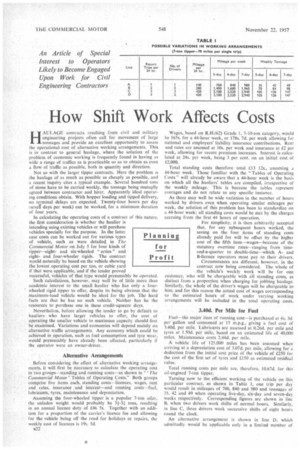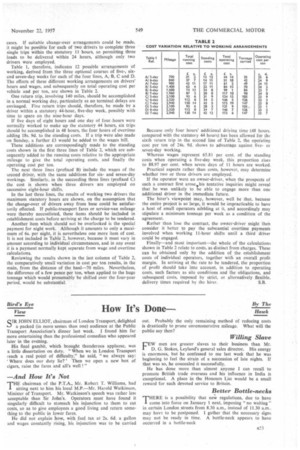How Shift Work Affects Costs
Page 56

Page 57

If you've noticed an error in this article please click here to report it so we can fix it.
HAULAGE contracts resulting from civil and military engineering projects often call for movement of large tonnages and provide an excellent opportunity to assess the operational cost of alternative working arrangements. This is in contrast to general haulage, where the solution of the problem of economic working is frequently found in having as wide a range of traffics as is practicable so as to obtain as even a flow of traffic as possible, both in quantity and direction.
Not so with the larger tipper contracts. Here the problem is the haulage of as much as possible as cheaply as possible, and a recent inquiry cites a typical example. Several hundred tons of stone have to be carried weekly, the tonnage being mutually agreed between contractor and hirer. Apparently ideal operating conditions obtain. With hopper loading and tipped delivery, no terminal delays are expected. Twenty-four hours per day (seveg days per week) can be worked, for a minimum duration of four years.
In calculating the operating costs of a contract of this nature, the first consideration is whether the haulier is intending using existing vehicles or will purchase vehicles specially for the purpose. In the latter case costs can be worked out for various types of vehicle, such as were detailed in The Commercial Motor on July 5 for four kinds of tipper—eightand six-wheeled " artics" and eightand four-wheeler rigids. The contract would naturally be based on the vehicle showing the lowest operating cost per ton, or cubic yard if that were applicable, and if the tender proved successful, vehicles of that type would presumably be operated.
Such calculations, however, may well be of little more than academic interest to the small haulier who has only .a four ' wheeled rigid tipper to offer, despite its being obvious that the maximum-load vehicle would be ideal for the job. The hard facts are that he has no such vehicle. Neither has he the resources to purchase one in these credit-squeeze days.
Nevertheless, before allowing the tender to go by default to hauliers who have larger vehicles to offer, the cost of operating the smaller vehicle to maximum capacity should first be examined. Variations and economies will depend mainly on
' alternative traffic arrangements. Any economy which could be achieved in operation, such as fuel consumption and tyre wear. would presumably have already been affected, particularly if the operator were an owner-driver. Pro Alternative Arrangements Before considering the effect of alternative working arrangements, it will first be necessary to calculate the operating cost in two groups—standing and running costs—as shown in "` The Commercial Motor' Tables of Operating Costs." Both groups comprise five items each, standing costs--licences, wages, rent and rates, insurance and interest—and running costs—fuel, lubricants,•tyres, maintenance and depreciation.
Assuming the four-wheeled tipper is a popular 7-ton oiler, the unladen weight would probably be 31-3i. tons, resulting in an annual licence duty of £46 5s. Together with an addition for a proportion of the carrier's licence fee and allowing for the vehicle being off the road for holidays or repairs, the weekly cost of licences is 19s. 5d.
e22 Wages, based on R.H.(62) Grade 1, 5-10-ton category, would he 165s, for a 44-hour week, or 178s. 7d. per week allowing for national and employers' liability insurance contributions. Rent and rates arc assessed at 10s. per week and insurance at 12 per week, allowing for recent premium increases. Interest is calculated at 24s. per week, being 3 per cent, on an initial cost of £2,000.
Total standing costs therefore total £13 12s., assuming a 44-hour week. Those familiar with the "Tables of Operating Costs" will already be aware that a 44-hour week is the basis on which all the hauliers' tables are compiled, irrespective of the weekly mileage. This is because the tables represent averages and do not relate to any specific instance.
As there may well be wide variation in the number of hours worked by drivers even when operating similar mileages per week, the solution of this problem has been to standardize on a 44-hour week; all standing costs would be met by the charges accruing from the first 44 hours of operation.
For simplicity, it is then arbitrarily accepted that, for any subsequent hours worked, the saving on the four items of standing costs already paid for will be offset by the higher cost of the fifth item—wages—because of the statutory overtime rates—ranging from timeand-a-quarter to double-time—which Aand B-licence operators must pay to their drivers. Circumstances are different, however, in the contract now being considered. The whole of the vehicle's weekly work will be for one customer, who will be chargeable with all standing costs, as distinct from a proportion when charging for jobbing haulage. Similarly, the whole of the driver's wages will be chargeable to him, and for this reason the actual cost of wages corresponding to the estimated hours of work under varying working arrangements will be included in the total operating costs.
fit
3.40d. Per Mile for Fuel
Fuel—the major item of running cost—is purchased at 4s. 3d. per 'gallon and consumed at '15 M.p.g., giving a fuel cost of 3.40d. per mile. Lubricants are assessed at 0.26d. per mile and lyres at 1.50d. per mile, based on an estimated life of 40,000 miles. Maintenance costs 2.44d. per mile.
A vehicle life of 125,000 miles has been assumed when arriving at a depreciation cost of 3.07d. per mile, allowing for a deduction from the initial cost price of the vehicle of £250 for the coSt of the first set of tyres and £150 as estimated residUal value. "
Total running costs per mile are, therefore, 10.67d. for this oil-engined 7-ton tipper.
Turning now to the efficient working of the vehicle on this particular contract, as shown in Table 1, one trip per day would result in mileages of 700, 840 and 980 and tonnages of 35, 42 and 49 when operating five-day, six-day and seven-day weeks respectively. Corresponding figures are shown in line B, when two drivers work shifts of normal hours. Similarly, its line C, three drivers work successive shifts of eight hours round the clock.
An alternative arrangement is shown in line D, which admittedly would be applicable only in a limited number of
eases. If suitable change-over arrangements could be made, it might be poAble for each of two drivers to complete three single trips within the statutory 11 hours, so permitting three loads to be delivered within 24 hours, although only two drivers were employed.
Table 1, therefore, indicates 12 possible arrangements of working, derived from the three optional courses of five-, sixand seven-day weeks for each of the four lines, A, B, C and a The effects of these different working arrangements on drivers' hours and wages, and subsequently on total operating cost per vehicle and per ton, are shown in Table 2,
One return trip, involving 140 miles, should be accomplished in a normal working day, particularly as no terminal delays are envisaged. Five return trips should, therefore, be made by a driver within a statutory 44-hour, five-day week, possibly with time to spare on the nine-hour days_ If five days of eight hours and one day of four hours were normally worked to make up the statutory 44 hours, six trips should be accomplished in 48 hours, the four hours of overtime adding 18s. 9d. to the standing costs. If a trip were also made on Sunday, a further £3 would be added to the wages bill.
These additions are correspondingly made to the standing costs shown in the first three lines of Table 2, which are subsequently added to the running costs relative to the appropriate mileage to give the total operating costs, and finally the operating cost per ton.
The next three lines (prefixed B) include the wages of the second driver, with the same additions for sixand seven-day workings. Similarly, in the succeeding three lines (prefixed C) the cost is shown when three drivers are employed on successive eight-hour shifts,
In the last three lines, the results of working two drivers the maximum statutory hours are shown, on the assumption that the change-over of drivers away from base could be satisfactorily effected. If public-transport fares or service-van mileage were thereby necessitated, these items should be included in establishment costs before arriving at the charge to be tendered.
Another item which should not be overlooked is the special payment for night work. Although it amounts to only a maximum of 6s. per night, it is nevertheless one more item of cost. It is not included in Table 2, however, because it must vary in amount according to individual circumstances, and in any event it is a payment normally kept separate from wage and overtime calculations.
Reviewing the results shown in the last column of Table 2, the comparatively small variation in cost per ton results, in the main, from the distance of the haul-70 miles. Nevertheless, the difference of a few pence per ton, when applied to the huge tonnage which would presumably be shifted over the four-year period, would be substantial. Because only four hours' additional driving time (48 hours. compared with the statutory 44 hours) has been allowed for the sixth return trip in the second line of Table 2, the operating cost per ton of 24s. 9d. shows to advantage against fiveor seven-day working.
Whereas wages represent 65.81 per cent, of the standing costs when operating a five-day week, this proportion rises to 88.97 per cent, when seven days of 11 hours are worked.
Practical aspects rather than costs, however, may determine whether two or three drivers are employed.
If the operator were an owner-driver, when the prospects of such a contract first arose.shis tentative inquiries might reveal that he was unlikely to be able to engage more than one additional driver in the immediate future.
The hirer's viewpoint may, however, well be that, because the entire project is so large, it would be impracticable to have a host of small operators nibbling at it, and accordingly may stipulate a minimum tonnage per week as a condition of the agreement.
Rather than lose the contract, the owner-driver might then consider it better to pay the substantial overtime payments involved when working 11-hour shifts until a third driver could be engaged.
Finally—and most important—the whole of the calculations shown in Table 2 relate to costs. as distinct from charges. These can be obtained only by the addition of the establishment costs of individual operators, together with an overall profit margin. In arriving at the rate to be tendered, the proportion of profit should take into account, in addition to operating costs, such factors as site conditions and the obligations, and subsequent costs, imposed by strict, or alternatively flexible.
delivery times required by the hirer. S.B.




























































































